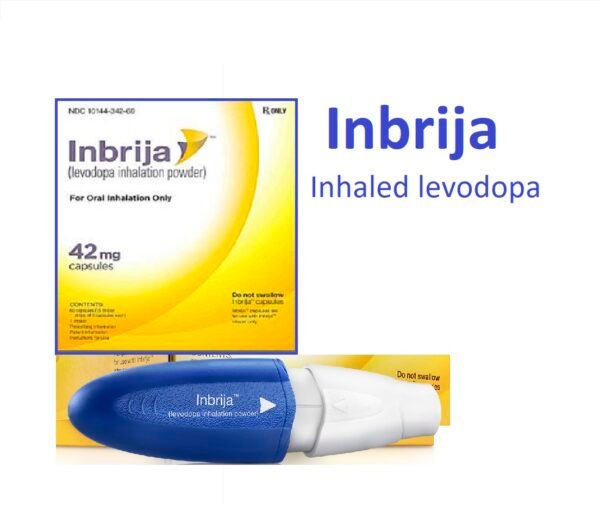Inbrija (Inhaled levodopa) is a rapidly acting inhalational formulation of levodopa that has a faster onset of action than oral levodopa. It is indicated for the "off episodes" in patients with Parkinson's disease that may manifest as worsening motor functions, difficulty in initiating movement, and increased body rigidity.
Inbrija (Inhaled levodopa) Uses:
-
Parkinson disease:
-
It is given to help Parkinson's disease patients who are taking levodopa/carbidopa manage their "off episodes."
-
Inhaled levodopa Dose in Adults:
Parkinson's disease treatment with Inbrija (inhaled levodopa) (as a supplement to carbidopa/levodopa):
-
Oral inhalation:
-
The most you can take at once is 84 mg, and in a whole day, it's up to 420 mg. You can use 84 mg inhaled at a time, and you can do this up to five times a day or as needed when the symptoms of an OFF period come back.
-
Use in Children:
Not recommended for children.
Use in Pregnancy: C
- When levodopa is taken by mouth, it can pass through the placenta to the developing baby.
- However, there is not much information available about the effects of levodopa on pregnancy.
- When levodopa is taken by mouth, it can pass through the placenta to the developing baby.
- However, there is not much information available about the effects of levodopa on pregnancy.
Breastfeeding: Inhaled Levodopa
Levodopa can get into breast milk.
The makers of the drug suggest that mothers who breastfeed should be careful if they use it.
They should think about the good and bad sides of the treatment for both themselves and their baby.
Dose in Kidney Disease:
The instructions from the manufacturer do not include information about adjusting the dose. Additionally, the drug has not been researched in patients with kidney disease.
Dose in Liver disease:
The manufacturer's instructions do not include details about adjusting the dosage. Furthermore, the drug has not been examined in patients with kidney disease.
Common Side Effects of Inbrija (Inhaled levodopa):
-
Respiratory:
- Cough
Less Common Side Effects of Inbrija (Inhaled levodopa):
-
Central Nervous System:
- Falling
- Headache
- Insomnia
- Hallucination
-
Respiratory:
- Upper Respiratory Tract Infection
- Discoloration Of Sputum
- Nasopharyngitis
- Oropharyngeal Pain
- Rhinorrhea
- Bronchitis
- Pneumonia
-
Gastrointestinal:
- Nausea
- Vomiting
-
Hematologic & Oncologic:
- Decreased Red Blood Cells
-
Dermatologic:
- Excoriation Of Skin
-
Neuromuscular & Skeletal:
- Dyskinesia
- Limb Pain
-
Miscellaneous:
- Laceration
-
Cardiovascular:
- Chest Discomfort
- Decreased Blood Pressure
- Orthostatic Hypotension
-
Hepatic:
- Increased Serum Bilirubin
Contraindications to Inbrija (Inhaled levodopa):
People who are currently using or have used MAOIs (such as phenelzine or tranylcypromine) should not take this medication. Additionally, it's important to wait at least 14 days after stopping MAOIs before starting this treatment.
Warnings and precautions
-
Abnormal thinking and behavior changes:
- A patient may experience abnormal mental state changes, such as agitation, aggression or delirium, confusion, and disorientation.
-
Depression in the CNS:
-
This medication can lead to central nervous system depression and drowsiness, which may affect both mental and physical abilities.
-
Patients should be reminded not to engage in tasks requiring mental alertness or higher mental functions, like driving or operating heavy machinery.
-
Symptoms of central nervous system depression can occur at any time, even up to a year after starting treatment.
-
It's crucial to check for any existing sleep disorders or the use of medications that might cause drowsiness.
-
Monitoring patients for signs of drowsiness is important.
-
If significant drowsiness occurs during the day, the treatment may need to be stopped.
-
There is limited information available on adjusting the dosage to alleviate these symptoms.
-
- Dyskinesias
-
- Patients with treatment-induced dyskinesia may need to be treated by discontinuing or increasing the dose.
-
Hallucinations
- Patients who experience confusion, excessive dreaming, or sleep disturbances may need to be reduced in dosage.
-
Disorders of impulse control:
- Patients who have lost control over their impulses or developed a strong urge to spend money may experience compulsive disorders.
- This has been observed in individuals using dopamine agonists to manage conditions like Parkinson's disease or restless leg syndrome.
- In some instances, discontinuing or reducing the dose of the treatment has resulted in a reversal of compulsive behaviors.
Patients who have lost control over their impulses or developed a strong urge to spend money may experience compulsive disorders. - This has been observed in individuals using dopamine agonists to manage conditions like Parkinson's disease or restless leg syndrome.
- In some instances, discontinuing or reducing the dose of the treatment has resulted in a reversal of compulsive behaviors.
-
Neuroleptic malignant Syndrome:
- Rapid withdrawal or reduction of drug doses can lead to clinical signs that look like NMS (neuroleptic malignant Syndrome).
- Hyperthermia, rigidity, and altered mental status must be checked. Patients should also be monitored for involuntary movements, and sweating, especially if the dose is being rapidly decreased.
- As soon as symptoms become apparent, it is important to initiate the appropriate treatment.
-
Glaucoma
- People with glaucoma should keep track of their eye pressure because this medication can potentially raise intraocular pressure.
- People with glaucoma should keep track of their eye pressure because this medication can potentially raise intraocular pressure.
-
Psychotic disorders
- It is best to avoid it for patients with schizophrenia or other major psychotic disorders.
-
Respiratory disease
- Patients with asthma and other bronchospastic conditions should not inhale levodopa.
Monitoring parameters:
Monitor liver function tests, BUN, Blood CBC (Blood CP), and the direct antiglobulin test. Monitor the patient for raised intraocular pressure if clinically indicated.
How to administer Inhaled levodopa?
This medication comes in oral capsules designed for inhalation purposes exclusively. It should not be swallowed, and the capsules should be thrown away after use.
The capsule is meant to be inhaled using the Inbrija inhaler and should be discarded after each use.
Mechanism of action of Inbrija (Inhaled levodopa):
Levodopa can pass through the blood-brain barrier and enters the brain. Once in the brain, it's released from the bloodstream and converted into dopamine by enzymes in the striatum.
In Parkinson's Disease, where there is a lack of dopamine in the striatum, levodopa is used to fill this gap.
This helps alleviate the symptoms and signs of the disease, leading to an improvement in the patient's condition.
Bioavailability:
- About 70% relative to availability from immediate-release formulation
Time to peak:
- Median 0.5 hours (range: 0.17 to 2 hours)
Half-life elimination:
- 2.3 hours
Metabolism:
- Extensive methylation and decarboxylation metabolism
International Brand Names of Inhaled levodopa:
- Inbrija
Inhaled Levodopa Brand Names in Pakistan:
No Brands Available in Pakistan.




